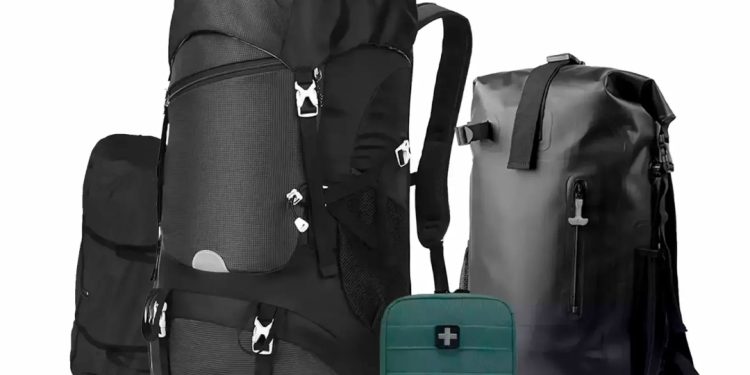In the realm of outdoor adventures and emergency preparedness, Survival Kit Backpacks are an essential item for anyone looking to ensure they have the necessary tools and supplies to face unforeseen circumstances.
The challenge, however, lies in packing these backpacks in such a way that they’re lightweight without missing out on critical items. This blog post will guide you through the process of creating a lightweight survival kit backpack, focusing on essential items and tips to minimize weight without compromising on safety or utility.
Understanding the Essentials of Survival Kit Backpacks
Survival Kit Backpacks are more than just ordinary bags; they are lifelines in emergency situations. The key is to include everything you might need in a survival scenario without overpacking. Essentials include water purification tools, a first-aid kit, non-perishable food items, a multi-tool, fire-starting equipment, and navigation aids. The goal is to strike a balance between preparedness and mobility.
Prioritizing Items in Your Backpack
When it comes to lightweight packing, prioritization is crucial. Start by listing all the items you think you need, and then categorize them based on their importance.
Water and food are non-negotiable, but perhaps you can opt for lighter alternatives like water purification tablets instead of a bulky filter, or high-calorie energy bars instead of canned food.
Selecting the Right Backpack
The first step to ensuring your survival kit is lightweight is choosing the right backpack. Opt for materials that are both durable and lightweight, such as nylon or polyester.
Additionally, look for backpacks with multiple compartments and adjustable straps to evenly distribute weight.
Emergency Medical Bags: A Critical Component
One of the most important components of Survival Kit Backpacks is the Emergency Medical Bag. While it’s essential to be prepared for medical emergencies, traditional medical kits can be bulky and heavy.
Opt for a compact, lightweight emergency medical bag that includes basic first aid supplies such as bandages, antiseptic wipes, pain relievers, and allergy medications. Tailor your medical kit to your personal needs and the nature of your trip, but keep it concise.
Lightweight Shelter and Warmth
Shelter and warmth are critical, but traditional tents and sleeping bags can add significant weight. Explore lightweight options like emergency bivvy bags or compact, lightweight sleeping bags designed for backpacking. Reflective blankets can also be a lifesaver, providing warmth without the bulk.
Food and Water Considerations
For food, focus on high-energy, lightweight options like energy bars, nuts, and dehydrated meals that only require water. Speaking of water, carrying multiple liters can quickly increase weight.
Instead, include a lightweight water filter or purification tablets, and plan your route where you’ll have access to natural water sources.
Tools and Miscellaneous Items
Choose multi-functional tools that can serve various purposes, such as a multi-tool or a knife with additional features. Include a lightweight flashlight or headlamp and spare batteries, a compact emergency whistle, and a small, durable mirror for signaling.
Packing Techniques for Weight Reduction
Packing technique can also make a difference in the overall weight of your backpack. Use compression bags to minimize the size of clothes and sleeping bags.
Organize items efficiently to distribute weight evenly, and utilize all available spaces, like stuffing socks or other small items into cookware.
Minimizing Weight with High-Efficiency Gear
In this section, we delve into the art of selecting high-efficiency gear that fulfills multiple purposes with minimal weight.
From versatile clothing layers adaptable to various weather conditions, to multi-use tools that combine functions of several heavier items, we explore how to make each ounce in your Survival Kit Backpack count.
Discover lightweight, durable gear that doesn’t compromise on functionality, ensuring you’re prepared for any situation without being weighed down.
Smart Packing Strategies for Lightweight Survival Kits
Smart packing goes beyond just selecting the right items; it involves strategic placement and organization within your backpack to optimize space and reduce bulk.
Learn how to employ techniques like rolling clothes to save space, utilizing every nook and cranny for efficient packing, and how to distribute weight evenly in your Survival Kit Backpack.
This section offers practical tips and tricks to pack your Emergency Medical Bags and other essentials in a way that maximizes space and minimizes weight, making your load more manageable and your journey more comfortable.
Conclusion
Packing a lightweight Survival Kit Backpack doesn’t mean leaving essential items behind. It’s about choosing the right items and packing them intelligently.
By focusing on multi-use tools, prioritizing essentials, and selecting lightweight alternatives, you can prepare a backpack that’s both comprehensive and manageable.
Remember, the goal is to be prepared, not overburdened. Safe travels and happy trails!


 Home
Home










